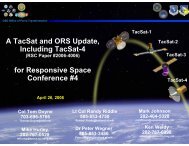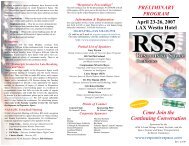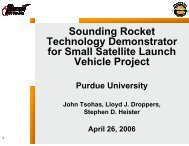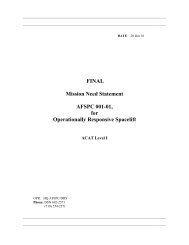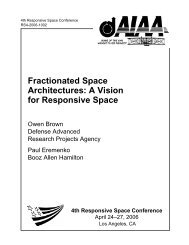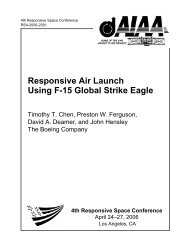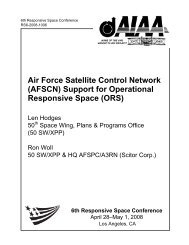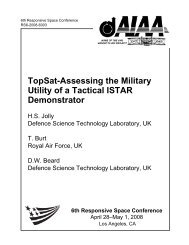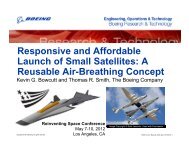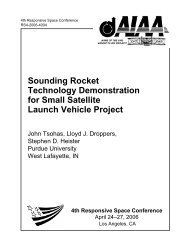Presentation - Responsive Space
Presentation - Responsive Space
Presentation - Responsive Space
Create successful ePaper yourself
Turn your PDF publications into a flip-book with our unique Google optimized e-Paper software.
<strong>Responsive</strong> Air Launch<br />
using<br />
F-15 Global Strike Eagle<br />
Timothy T. Chen, Preston W. Ferguson,<br />
David A. Deamer, and John Hensley<br />
The Boeing Company, Huntington Beach, CA<br />
Paper No. AIAA-RS4-2006-2001 1<br />
4 th <strong>Responsive</strong> <strong>Space</strong> Conference, Los Angeles, CA, April 24 th ~ 26 th , 2006
Acknowledgement<br />
Study Team Members<br />
• Tom Mead (Lead)<br />
• Billy Burroughs<br />
• Greg Larson<br />
• Richard Hora<br />
• Curt Wiler<br />
• Todd Magee<br />
• Peter Hartwich<br />
Paper No. AIAA-RS4-2006-2001 2<br />
4 th <strong>Responsive</strong> <strong>Space</strong> Conference, Los Angeles, CA, April 24 th ~ 26 th , 2006
Need for On-Demand, <strong>Responsive</strong> <strong>Space</strong> Launch<br />
• Global Strike, <strong>Responsive</strong> <strong>Space</strong>lift and <strong>Space</strong> Control Missions<br />
– Tactically responsive space and munitions launch<br />
• Micro and Nano satellites to supplant or augment large satellites<br />
– Augmentation of existing constellations during conflicts (C4ISR)<br />
– Defensive or Offensive counter-space<br />
– Low cost space technology testbed<br />
Mini-satellite Micro-satellite Nano-satellite<br />
>450 kg 50 - 449 kg 0.5 - 49 kg<br />
Globalstar, Quickbird,<br />
Iridium, StarBus, PegaSta<br />
XSS-10/11, OPAL, TacSat-1,<br />
JWS-2, Microsat-70/100,<br />
Minisat-400, Ofeq-3,<br />
MightySat I<br />
DARPA Picosat,<br />
FalconSat, EyeSat,<br />
MegSat, SNAP,<br />
ST-5, Microstar<br />
Paper No. AIAA-RS4-2006-2001 3<br />
4 th <strong>Responsive</strong> <strong>Space</strong> Conference, Los Angeles, CA, April 24 th ~ 26 th , 2006
F-15 Air Launch Solution – A Conceptual Evaluation<br />
• Spiral capability for near-term operationally significant missions<br />
– F-15 C/D to F-15E<br />
– Payload class range from < 100 lbm to 600+ lbm to LEO<br />
• Improved performance<br />
– Up to 5,000 fps delta-V reduction for launch vehicle vs. ground launch<br />
– “All azimuth” launch capability<br />
• CONUS and non-CONUS launch<br />
– Not limited to existing Range assets<br />
• Mission flexibility<br />
– Covert launches<br />
• Look just like another F-15<br />
– Forward base options (can be based anywhere there’s US AFB)<br />
– Rapid response time<br />
– Recall capability<br />
– Blue suit operation<br />
Paper No. AIAA-RS4-2006-2001 4<br />
4 th <strong>Responsive</strong> <strong>Space</strong> Conference, Los Angeles, CA, April 24 th ~ 26 th , 2006
Additional Benefit of F-15 Air Launch<br />
• Low system development cost, risk and schedule<br />
– Existing assets, infrastructure, maintenance personnel and training<br />
– Minimum modification to adapt F-15E to F-15GSE<br />
• maintain ability to return to service<br />
• Low risk platform for developing DARPA FALCON-like technologies<br />
– Hypersonic test bed for DARPA technologies<br />
– Separation demonstrator for Hybrid Launch Vehicle (HLV) concepts<br />
• Supporting Affordable <strong>Responsive</strong> <strong>Space</strong>lift (ARES)<br />
Paper No. AIAA-RS4-2006-2001 5<br />
4 th <strong>Responsive</strong> <strong>Space</strong> Conference, Los Angeles, CA, April 24 th ~ 26 th , 2006
Previous F-15 Launch Concepts<br />
ASAT (Anti-Satellite) missile system consisted of a modified<br />
Short Range Attack Missile (SRAM) first stage plus an<br />
ALTAIR III second stage with a Miniature Homing Vehicle<br />
(MHV) warhead. It was launched from an F-15 aircraft<br />
to destroy low earth orbiting satellites.<br />
ASAT program<br />
USAF Systems Command <strong>Space</strong> Division (1976~1988)<br />
Aerospace Corporation<br />
Launch-on-Demand Booster Study, April, 1999<br />
AFRL, Kirtland AFB<br />
“<strong>Responsive</strong> <strong>Space</strong> Launch The F-15 Microsatellite<br />
Launch Vehicle” Study, April, 2003<br />
• Focused on under-pylon LV carry<br />
– Limited LV size and weight capability<br />
– Limits to < 100 kg payload to orbit<br />
From: “RESPONSIVE SPACE LAUNCH THE F-15 MICROSATELLITE LAUNCH VEHICLE”<br />
By Lt Julia Rothman, Lt Erika Siegenthaler, Air Force Research Laboratory, <strong>Space</strong> Vehicles<br />
1st <strong>Responsive</strong> <strong>Space</strong> Conference, April 1–3, 2003, Redondo Beach, CA<br />
Paper No. AIAA-RS4-2006-2001 6<br />
4 th <strong>Responsive</strong> <strong>Space</strong> Conference, Los Angeles, CA, April 24 th ~ 26 th , 2006
F-15GSE Concept for Higher Payload Capability<br />
Paper No. AIAA-RS4-2006-2001 7<br />
4 th <strong>Responsive</strong> <strong>Space</strong> Conference, Los Angeles, CA, April 24 th ~ 26 th , 2006
F-15 Global Strike Eagle Specifications<br />
Boeing F-15 Global Strike Eagle Specifications<br />
Wingspan: 42 feet 9.75 inches Maximum Speed: 1650 MPH at 36,000 feet<br />
Length: 63 feet 9 inches Separation Speed: 890 MPH at 47,800 feet<br />
Height: 18 feet 5.5 inches Service Ceiling: 60,000 feet<br />
Empty Weight 31,700 pounds Range: TBD miles<br />
Maximum Weight 81,000 pounds Crew: No flight crew (launch), One (ferry)<br />
Global Strike Mission GTOW 75,000 pounds<br />
Power plant<br />
Two 29,000 pound thrust F-100-PW-229 afterburning turbofan engines<br />
Boeing Global Strike Missile Specifications (OSC Minotaur 3 upper stages)<br />
Wingspan: 10 feet 0 inches Maximum Dynamic Pressure: 1400 PSF at 29,900 feet (pre-separation)<br />
Length: 45 feet 0 inches Orbital Payload Capability 600 pounds (100 nmi x 28.5° inclination)<br />
Gross Separation Weight 29,700 pounds Ballistic Payload Capability ~1200 pounds (28.5° inclination)<br />
Solid Rocket Motors SR-19 (Stage 2)/Orion 50XL (Stage 3)/Orion 38 (Stage 4)<br />
Paper No. AIAA-RS4-2006-2001 8<br />
4 th <strong>Responsive</strong> <strong>Space</strong> Conference, Los Angeles, CA, April 24 th ~ 26 th , 2006
Existing Off-the-Shelf SRM for F-15 GSE Launch Vehicle<br />
Orion 38 - Pegasus XL Stage 3<br />
Payload<br />
Fairing<br />
Orion 50XL - Pegasus XL Stage 2<br />
SR-19 - Minuteman II Stage 2<br />
Interstage<br />
Aft-Cone Body<br />
Aero Surface Fins<br />
Orion Orion 38 38<br />
Orion<br />
Orion<br />
50<br />
50<br />
XL<br />
XL<br />
SR-19 SR-19<br />
Paper No. AIAA-RS4-2006-2001 9<br />
4 th <strong>Responsive</strong> <strong>Space</strong> Conference, Los Angeles, CA, April 24 th ~ 26 th , 2006
High Fidelity CFD Analyses Suggest F-15GSE is Devoid of<br />
Aerodynamics Show Stoppers<br />
F-15E with Missile in Proximity<br />
F-15E with<br />
Missile in<br />
Proximity<br />
Pressure Field in Crossplane at X=50 ft<br />
Surface Pressures<br />
(Top View)<br />
F-15E Alone<br />
BCFD Euler, M ∞<br />
=2.25, α=1.47°, altitude=36.8 kft, engine mass flow corr<br />
= 156.9 lbm/sec<br />
F-15E Alone<br />
Change in angle-of-attack by ~1 degree will compensate for lift decrement<br />
Paper No. AIAA-RS4-2006-2001 10<br />
4 th <strong>Responsive</strong> <strong>Space</strong> Conference, Los Angeles, CA, April 24 th ~ 26 th , 2006
High-Fidelity Analyses Show Favorable Flow Interactions<br />
Between F-15E and Launch Vehicle for Separation Release<br />
Surface Pressures &<br />
Centerplane Pressure Field<br />
F-15E with Missile in Proximity<br />
F-15E Alone<br />
Channel flow between<br />
missile and F-15E is<br />
devoid of low<br />
pressures that could<br />
lead to suction of<br />
missile toward F-15E<br />
High pressure pockets<br />
along keel of missile<br />
promote separation<br />
Compared to F-15Ealone,<br />
flow<br />
interactions in channel<br />
between missile and<br />
airframe increase<br />
pressure in expansion<br />
pockets over crown<br />
line<br />
BCFD Euler, M ∞<br />
=2.25, α=1.47°, altitude=36.8 kft, engine mass flow corr<br />
= 156.9 lbm/sec<br />
Paper No. AIAA-RS4-2006-2001 11<br />
4 th <strong>Responsive</strong> <strong>Space</strong> Conference, Los Angeles, CA, April 24 th ~ 26 th , 2006
4 Primary Bulkheads Provide 8 Robust Attach Points for<br />
Payload Attach-Distribution-Reaction<br />
FS595<br />
FS626<br />
FS558<br />
FS509<br />
FS626<br />
FS509<br />
FS558<br />
FS595<br />
Paper No. AIAA-RS4-2006-2001 12<br />
4 th <strong>Responsive</strong> <strong>Space</strong> Conference, Los Angeles, CA, April 24 th ~ 26 th , 2006
F-15/ Launch Vehicle Altitude Profile<br />
F-15/LV Altitude Profile<br />
F-15 (Stage1)Pitch-up Maneuver<br />
Time: 270 sec<br />
Altitude: 27,700 ft<br />
M: 1.7, Alpha: 2.4°, Gamma: 0°<br />
Q: 1400 psf<br />
F-15/LV Separation<br />
Time: 309 sec<br />
Altitude: 47,800 ft<br />
M: 1.35, Alpha: 0.0°, Gamma: 40.4°<br />
Q: 345 psf<br />
LV Stage 1 Ignition<br />
Time: 313 sec<br />
Altitude: 51,500 ft<br />
M: 1.24<br />
Velocity: 1305 fps<br />
Alpha: 0.0°, Gamma: 34.7°<br />
Q: 240 psf<br />
Paper No. AIAA-RS4-2006-2001 13<br />
4 th <strong>Responsive</strong> <strong>Space</strong> Conference, Los Angeles, CA, April 24 th ~ 26 th , 2006
Launch Vehicle Altitude Profile<br />
Launch Vehicle Altitude Profile<br />
LV Stage 3/Payload Separation<br />
Time: 671 sec<br />
Altitude: 620,500 ft (102 nmi.)<br />
M: 27.0<br />
Velocity : 24198 fps<br />
Alpha: -1.4°, Gamma: 0.0°<br />
LV Stage 3 Ignition<br />
LV Stage 1 Ignition<br />
Time: 313 sec<br />
Altitude: 51,500 ft<br />
M: 1.24<br />
Velocity: 1305 fps<br />
Alpha: 0.0°, Gamma: 34.7°<br />
Q: 240 psf<br />
LV Stage 1/2 Separation<br />
Stage 2 Ignition<br />
Time: 380 sec<br />
Altitude: 122,800ft<br />
M: 6.13<br />
Velocity : 6289 fps<br />
Alpha: 10.4°, Gamma: 14.7°<br />
Q: 220 psf<br />
LV Stage 2/3 Separation<br />
Stage 3 Coast<br />
Time: 451 sec<br />
Altitude: 282,600 ft<br />
M: 18.1<br />
Velocity : 16,158 fps<br />
Alpha: 8.4°, Gamma: 12.2°<br />
Q: 1.7 psf<br />
Time: 624 sec<br />
Altitude: 611,600 ft (100 nmi.)<br />
M: 17.7<br />
Velocity : 15,857 fps<br />
Alpha: 6.5°, Gamma: 1.6°<br />
Paper No. AIAA-RS4-2006-2001 14<br />
4 th <strong>Responsive</strong> <strong>Space</strong> Conference, Los Angeles, CA, April 24 th ~ 26 th , 2006
Payload Performance Growth Options Exist for the Design<br />
• F-15GSE Enhancements<br />
– With “JATO” type propulsion boosters<br />
– MIPCC option<br />
• LV Booster Options<br />
– Liquid fuel stages<br />
– Optimized SRMs<br />
Payload Performance Growth with Liquid Boosters<br />
2,000<br />
Payload Weight to LEO (lbm)<br />
1,800<br />
1,600<br />
1,400<br />
1,200<br />
1,000<br />
800<br />
600<br />
400<br />
200<br />
DARPA FALCON Requirement<br />
0<br />
Baseline Solids (SRM)<br />
Pressure-Fed Liquids<br />
(NTO/AZ-50)<br />
Pressure-Fed Liquids<br />
(LO2/RP)<br />
Pump-Fed Liquids (LO2/RP)<br />
Paper No. AIAA-RS4-2006-2001 15<br />
4 th <strong>Responsive</strong> <strong>Space</strong> Conference, Los Angeles, CA, April 24 th ~ 26 th , 2006
Low-Cost Liquid Booster Engines<br />
60K lbf Pump-Fed Engine<br />
Fastrack Engine Turbopump<br />
60K lbf Pressure-Fed Engine<br />
Bantam<br />
First Unit Actual Cost - $136K<br />
Final Weight - 579 lbs<br />
Recurring cost target - $86,000<br />
Paper No. AIAA-RS4-2006-2001 16<br />
4 th <strong>Responsive</strong> <strong>Space</strong> Conference, Los Angeles, CA, April 24 th ~ 26 th , 2006
Conclusion<br />
• Conceptual evaluation of F-15 supports a spiral development of airlaunch<br />
capability<br />
– Initial limited capability using F-15 C/D<br />
• with under-wing or center-mount carry<br />
– Existing F-15E with OTS SRM provides 600 lbm payload to LEO<br />
– Growth path to over 1,000 lbm payload to LEO capability<br />
• Low cost micro- and nano- satellite technology test bed<br />
• Hypersonic test bed for DARPA technologies<br />
– HLV separation demonstrator<br />
Paper No. AIAA-RS4-2006-2001 17<br />
4 th <strong>Responsive</strong> <strong>Space</strong> Conference, Los Angeles, CA, April 24 th ~ 26 th , 2006



